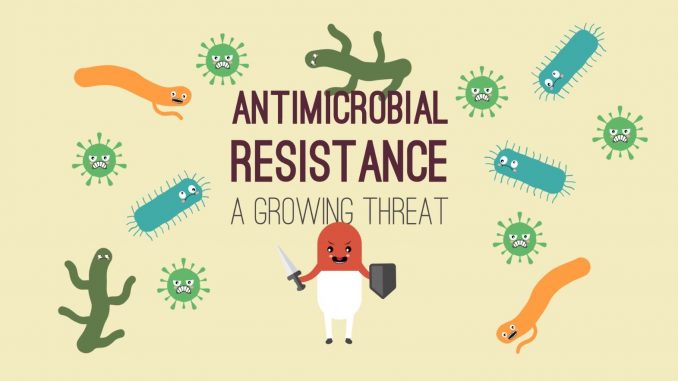
What is Antimicrobial Resistance (AMR)?
- Antimicrobial Resistance (AMR) can be simply understood as the resistance shown by the microorganism against an antimicrobe.
- It is the ability of the microorganism to stop antimicrobial to act against them. As a result, effectiveness of antimicrobial is reduced, treatment becomes ineffective and disease/infection continue.
- Antimicrobial resistance (AMR) is a complex global public health challenge. It has been a worldwide problem in healthcare today.

- AMR occurs when bacteria changes in a way that which reduces the effectiveness of the antibiotics. As a result, bacteria will continue to grow and become stronger eventually. When these microorganisms become resistant to most of the antimicrobial they are often referred as “superbugs”.
- AMR is growing as a serious public health threat globally and although it is a natural phenomenon in microorganisms, it has been accelerated by the misuse of antimicrobial agents in humans and animals.
- Globally, the most frequently prescribed antibiotics are azithromycin and amoxycillin.
Status quo of Antimicrobial Resistance/Problem statement:
- 2 million people in US are infected with antibiotic resistant bacteria annually and at least 23,000 of them die (annually)
- Only in US, estimated cost of AMR is $55 billion per year where $20 billion accounts for direct health costs while $35 billion accounts for loss of productivity (CDC)
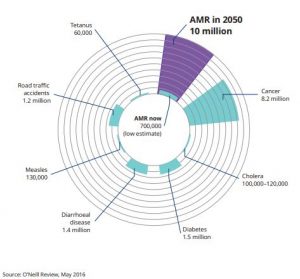
- Use of antibiotics has been excessively unnecessary. A study done in Europe in 2013 revealed antibiotic use of 35% among hospitalized patients. It is expected to be more in developing and least developed nations.
- Likewise, in US, in an average, 60% of all patients received at least one antimicrobial medicine during their hospital stay.
- CDC estimates that almost half of all antibiotics prescribed are unnecessary.
- Discovery void of antibiotics
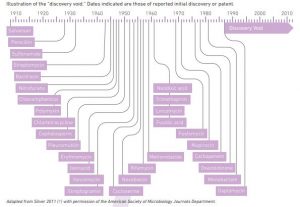
Reasons for increasing Antimicrobial Resistance (AMR):
There are multiple reasons because of which Antimicrobial resistance is increasing everyday globally. Some of the major reasons are:
- Overprescribing of antibiotics by the health care providers
- Over the counter (OTC) sales of antibiotics
- Lack of compliance in use of antibiotics i.e. not completing the full dose as prescribed
- Poor infection control in health facilities
- Lack of rapid laboratory tests which may lead to wrong use of drugs
- Poor hygiene and sanitation practices
- Unnecessary use/overuse of antibiotics
- Perception of antibiotics as ‘wonder drugs’ which can cure all diseases
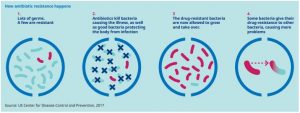
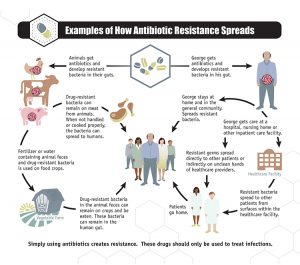
- Self-medication
- Lack of adequate surveillance
- Knowledge gap about the rationale use of antibiotics
- Improper use of antibiotics on treatment of viral infections like cold, flu, most of the sore throats etc.
- Lack of coordinated global AMR surveillance
- Lack of population-based AMR surveillance
Effects of Antimicrobial Resistance (AMR):
- Poor health and slow recovery of the patient
- Increased severity of diseases
- Rising economic burden on the health care system, as the treatment costs of antibiotic resistance is very high and time taking
- Increased social costs of the patient and the nation, due to poor health and decreased productivity
- Increased opportunity costs
- Chances of moving towards ‘post antibiotic era’ where common infections may become fatal
Strategies to reduce or control Antimicrobial Resistance:
- Health education among the general public about the rationale use of antibiotics
- Information campaigns targeting the consumers, and health care providers including family doctors and nurses
- Strict monitoring and enhanced surveillance system
- Introduction of new vaccines
- Rapid diagnostic tool to reduce the clinical uncertainty
- Stringent rules and regulations against Over the Counter (OTC) sale of antibiotics
- Use of multiprong approaches
- Use of mass media and knowledge sharing platforms to advocate about the advantages and threats of antibiotics
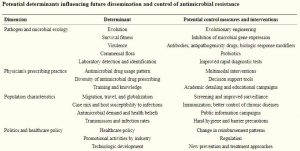
- Avoid antibiotics for viral infections
- Neither share your nor use antibiotics prescribed for others
- Do not use the leftover antibiotics of previous infection, unless prescribed
- Expanded research on new possibilities
- International collaboration and partnerships to reduce resistance and strengthen regional and global surveillance system
- Development of standard tools for harmonized surveillance
- Coordination and collaboration between existing surveillance networks and surveillance centers
- Strengthen programs and policies for infection prevention and control
Furthermore, according to an article (The Evolving Threat of Antimicrobial Resistance) published by WHO in 2012 published, various alternative combination of interventions for fighting against Antimicrobial Resistance (AMR) include:
- Strengthening health systems and surveillance
- Improving use of antimicrobials in hospitals and in community
- Infection prevention and control
- Encouraging the development of appropriate new drugs and vaccines and
- Political commitment
References and for more information:
www.who.int/features/qa/75/en/
https://www.cdc.gov/drugresistance/threat-report-2013/index.html
https://www.rxlist.com/antibiotic_resistance/drugs-condition.htm
https://www.britannica.com/science/antibiotic-resistance
https://academic.oup.com/cid/article/36/11/1433/304950
http://phri.org/news/Review%20Drlica,SV08.pdf
http://www.brinknews.com/asia/antimicrobial-resistance-implications-for-asia/
https://www.ncbi.nlm.nih.gov/pmc/articles/PMC4768623/
https://www.coursera.org/learn/antimicrobial-resistance
http://www.oecd.org/health/antimicrobial-resistance.htm
https://www.fda.gov/AnimalVeterinary/SafetyHealth/AntimicrobialResistance/default.htm
https://www.bmj.com/content/317/7159/609.short
https://www.ncbi.nlm.nih.gov/pmc/articles/PMC3367590/
https://www.ncbi.nlm.nih.gov/pmc/articles/PMC2730242/
http://www.pharmacytimes.com/publications/issue/2004/2004-12/2004-12-4835
https://www.cdc.gov/drugresistance/about.html
https://www.bmj.com/anti-microbial-resistance
https://infectioncontrol.tips/2015/11/18/6-factors-that-have-caused-antibiotic-resistance/
http://www.fao.org/antimicrobial-resistance/en/
https://www.online-sciences.com/health/antibiotics-advantages-and-disadvantages/
https://www.nap.edu/read/5137/chapter/5
http://www.who.int/antimicrobial-resistance/en/
http://www.euro.who.int/en/health…/how-to-reduce-the-spread-of-antibiotic-resistance
http://www.pharmacytimes.com/publications/issue/2004/2004-12/2004-12-4835
Suetens C, Hopkins S, Kolman J, Diaz Högberg L. Point prevalence survey of healthcare associated infections and antimicrobial use in European acute care hospitals. Stockholm, Sweden: European Centre for Disease Prevention and Control; 2013.
https://www.cdc.gov/features/antibioticuse/
http://www.who.int/en/news-room/fact-sheets/detail/antibiotic-resistance
http://apps.who.int/iris/bitstream/handle/10665/193736/9789241509763_eng.pdf?sequence=1
https://antibiotic.ecdc.europa.eu/en